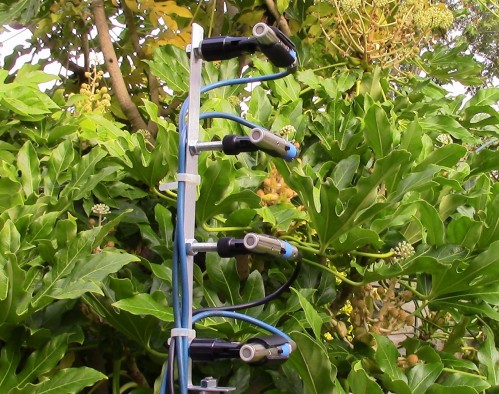
A handy little pre-amp for my line array. A Shure M268 4 x channel Mono Microphone Mixer. Surprisingly clean-sounding for its age!
Line array theory has been around since the 1930’s. In the 50’s and 60’s basic line arrays were very popular in the form of the column loudspeaker commonly used for PA. These days we are used to seeing massive line array speaker systems flown above the stage at festivals and concerts.
On the other hand the line array microphone is a rare breed and the few that are around, such as the impressive Microtech Gefell KEM970, tend to be expensive. The KEM970 is around £10,000.
In common with the shotgun microphone, the line array is a phase-reactive device. Unlike the shotgun where the on-axis position is down the length of the interference tube, with the line array the on-axis position is side-on at 90 degrees to the vertical column. Sound arriving at 90 degrees will be in phase at all of the capsules. The electrical output from each capsule will be identical and therefore additive. Sound arriving off-axis will suffer varying degrees of phase cancellation, depending on the frequency and the angle of incidence.
The polar pattern of a line array microphone is therefore wide in the horizontal plane and narrow in the vertical, getting narrower with rising frequency. This enables the mic to pick up over longer distances whilst rejecting mid and high frequency sound arriving off axis ( ie below and above.)
N.B.The longer the array (ie the more elements in the line) the lower the frequency at which it starts to be effective.
Below about 400Hz my 4 element model becomes increasingly omni-directional. In this respect it is once again similar to a shotgun.
Over the next few months I am planning a number of experiments to explore how this array will behave and to see what practical applications I can find for it! I’ll report back…………..
.




Hey Martin. Just stumbled across your post on the line array microphones. Did you really measure the polar plot? What about lower frequencies 200-500 Hz? What spacing did you use between the mics. I would be very glad to get some more information. Great Stuff. Many thanks and best regards. Stefan.
LikeLike
Hi Stefan, The spacing between the elements is 0.1m. The plot pictured here is simply a theoretical plot for omnidirectional mics. Unfortunately I don’t have the facilities to do a detailed plot of these actual mics.
Below 500Hz this array very rapidly becomes omnidirectional. In order to lower the point at which the array is directional a longer line is required. The longer the array and the more the elements used, the lower the point at which itr starts to be omnidirectional.
All the Best
Martin
LikeLike
See also Beyerdynamic ‘Revoluto’ and Gefell KEM-970 , KEM-975.
LikeLike
Some weeks ago I purchased a Beyerdynamic MPR 210W. Very useful mic. I’ll be writing about it in the not too distant future.
LikeLike